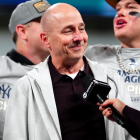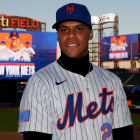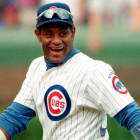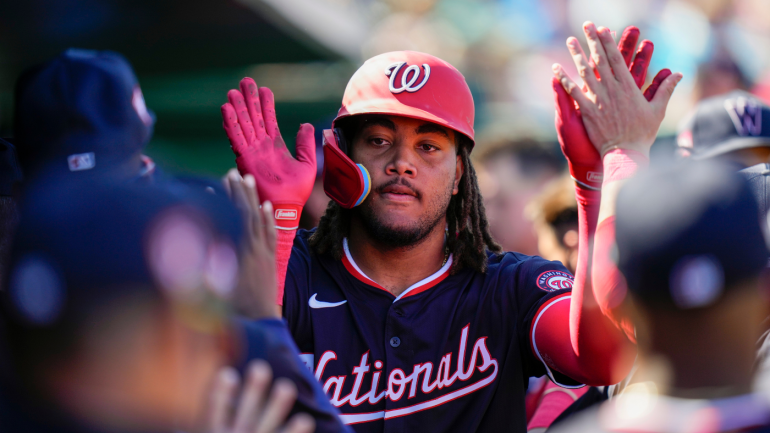
Pittsburgh Pirates right-hander Paul Skenes made his big-league debut on Saturday, showcasing a 100 mph fastball and striking out seven batters without earning a decision versus the Chicago Cubs. (You can read more about Skenes' start by clicking here.) In the process, Skenes became the fourth prospect ranked in CBS Sports' 2024 top 10 to reach the shores of the major leagues this season, joining Jackson Holliday, Wyatt Langford, and Jackson Chourio. (Two other members of the top-10 list debuted last year, in Tampa Bay Rays infielder Junior Caminero and Texas Rangers outfielder Evan Carter.)
In this era of dwindling attention spans, you might just wonder -- who's next? From our perspective, we think there's one obvious candidate: Washington Nationals outfielder James Wood.
Top 10 prospects yet to make MLB debut:
| Player | Preseason rank | Level | OPS |
|---|---|---|---|
OF Dylan Crews (Nationals) | 5 | Double-A | .779 |
OF James Wood (Nationals) | 6 | Triple-A | 1.025 |
C Ethan Salas (Padres) | 8 | High-A | .563 |
OF Walker Jenkins (Twins) | 9 | A-ball | (only one at-bat due to injury) |
Wood, 21, was the 6-foot-7 centerpiece of the trade that sent Juan Soto to the San Diego Padres. (The Nationals also received left-hander MacKenzie Gore and shortstop CJ Abrams in a deal that has worked out better than expected for them given they were parting with a young hitter on a Hall of Fame trajectory.) CBS Sports ranked him as the sixth-best prospect back in February, summarizing him as a "towering outfielder with great patience and power." Thus far this season in Triple-A, he's batted .346/.444/.581 with seven home runs and nine stolen bases (on 10 tries) in 35 games.
It is, then, only a matter of time before Wood makes his big-league debut. Below, CBS Sports has highlighted five things to know about his game and the potential timing of his promotion.
1. Elite strength
If you absorb nothing else about Wood, know this: he hits the ball hard.
James Wood has been getting on base all year, and now the @Nationals' No. 2 prospect has tapped into his power.
— MLB Pipeline (@MLBPipeline) May 11, 2024
Four homers in his past three games for the @RocRedWings. pic.twitter.com/uTfeGYZmH1
Wood enters Monday sporting a seasonal exit velocity of 94.6 mph, the same as Los Angeles Dodgers superstar Shohei Ohtani. Of course, it would be unfair to describe those numbers as being equal: Ohtani has produced his against MLB pitching; Wood has tallied his against Triple-A arms.
Still, Wood's innate strength is impressive. His hardest-hit ball checked in at 115.3 mph, a figure that would rank 13th this season among MLB hitters, just ahead of Kyle Schwarber, Marcell Ozuna, and William Contreras. He's also already cleared the 110-mph mark on 10 occasions. For reference, only six MLB hitters have cleared 110 mph that often this year: Vladimir Guerrero Jr., Juan Soto, Giancarlo Stanton, the aforementioned Ohtani, Bobby Witt Jr., and Yordan Alvarez.
That's great company to keep for anyone, let alone for a 21-year-old.
2. One notable similarity with Soto
Whenever you have a hitter like Wood with an enormous amount of raw strength, you might suspect that he's going up to the plate and trying to hit a home run every time up. That often entails swinging with an upward trajectory that results in a lot of fly-ball contact. In the process, the batter reduces their capacity for hitting for average while maximizing their damage-to-hit ratio.
That's not the case at all here, as evidenced by Wood's 52.4% ground-ball rate this season. In fact, he shares something in common with Soto, in that they both tend to make a lot of low-flying contact. Take a look at this comparison between Wood and Soto's seasonal numbers:
| Player | Exit Velocity | Launch Angle | 10-30 degrees% | 95 mph+% |
|---|---|---|---|---|
Wood (Triple-A) | 94.6 mph | 3.5 degrees | 35.2% | 57.7% |
Soto (MLB) | 95.3 mph | 10 degrees | 29% | 60.1% |
Now, let's look at the data another way by comparing their launch angles on their hardest-hit balls, or, in this case, the batted balls that cleared 95 mph:
Wood: 5.1 degrees
Soto: 13.6 degrees
In short: Soto is more inclined to lifting his hardest-struck balls, usually within the line-drive bin of 10 to 25 degrees; Wood, meanwhile, is more likely to impact balls that fall in the ground-ball bin.
Clearly that hasn't prevented Wood from getting his share of home runs (he's averaged almost 30 per 162 games). It will be interesting to see if the Nationals do attempt to get him to sky the ball more often. While his current approach has been effective for him throughout his professional career, there's always a strong temptation to maximize slugging from players with elite strength -- particularly when the upside could entail a few 40-plus home-run seasons.
3. Some strikeout concerns
It's easy to forget now, but there were valid reasons why Wood slipped to the second round in his draft year, as well as why the Padres were willing to part with him as part of a larger package. The main blemish to his game is his tendency to strike out a lot. Wood, a disciplined hitter willing to work deep counts, tends to swing and miss a fair amount (as is often the case with hitters of his size), resulting in at-times scary strikeout rates. So far this season, Wood has had some swing-and-miss issues with pitches up in and above the zone over the middle of the plate:
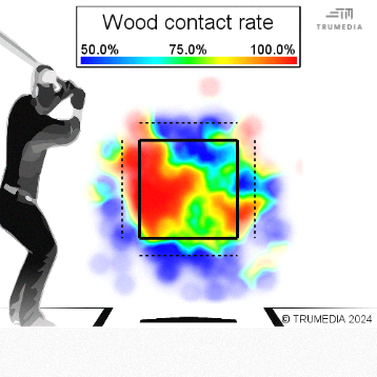
Wood entered Monday with a 70.8% contact rate, as compared to the big-league average of 75.6% among qualified hitters. It is worth noting that his contact rate on in-zone swings is 83%, or right in line with the MLB average of 83.2%. Now, again, Wood is putting up those numbers versus Triple-A arms instead of their big-league counterparts; that, in turn, suggests his contact rates could slip upon a promotion to The Show.
The good news is that Wood's combination of power and patience should give him a wide berth in this respect. He's going to be just fine if he can keep his K rate on the sunny side of 30%.
4. Better against righties
Something else to monitor about Wood's game is how he performs versus left-handed pitchers. This season, he's batting .212/.297/.515 without the platoon advantage, as opposed to .388/.488/.602 with it. In 2023, he had a .792 OPS against lefties, and that was accompanied by a 6.00 strikeout-to-walk ratio -- a great mark for a pitcher, but a terrible one for a potential middle-of-the-order hitter.
James Wood clubs his 2⃣nd homer of the day, 5⃣th in his last three games at Triple-A.
— MLB Pipeline (@MLBPipeline) May 11, 2024
MLB's No. 12 prospect has piled up seven roundtrippers for the @RocRedWings this season. pic.twitter.com/1k39VMlMir
That isn't to suggest Wood is going to require pairing with a right-handed sock.
The reality is that a lot of left-handed hitters struggle against same-handed pitching. Lefties as a whole this season are batting .231/.302/.357 in the majors when they're tasked with southpaws -- that's nearly 20 OPS points worse than how right-handed perform against fellow righties. As such, there's every reason to think that Wood should be (and remain) an everyday player once he reaches the majors.
5. Service-time implications
Do note that we used "implications," not "manipulation." The Nationals were justified in starting Wood in Triple-A, and we don't think they've crossed a line by keeping him there to date. The timing of Wood's promotion will get more interesting from here, though, since we're nearly upon the next relevant service-time milestone: the approximate Super Two threshold.
For those not in the know, almost every MLB player gets three years of arbitration eligibility once they clear the three-year mark of service time. (Arbitration is important because it's the first time in a player's career they stand to make more than the league minimum.) A select group gets four arb years -- those who fall in the top 22% of service time between two and three years of service. Since that additional year of arbitration cuts into a team's cost savings, you often used to see clubs make a point of manipulating their best prospects' service time to avoid that designation. The newest collective bargaining agreement has seemingly curbed that behavior by incentivizing teams with extra draft picks if they carry a player on their Opening Day roster and they win awards.
Prospects and veterans, mashing together. @Nationals up-and-comer James Wood and rehabber Joey Gallo go back-to-back for @RocRedWings. pic.twitter.com/jLpSfyuIJk
— Minor League Baseball (@MiLB) May 11, 2024
In recent years, the Super Two cutoff has usually fallen between two years and 115 days and two years and 130 days of service. A player can earn up to 172 days of service in a single season, meaning that the Nationals would need to keep Wood in the minors for at least 60 days to feel confident about him missing out on the Super Two designation down the road. That leaves the Nationals a few weeks off from accomplishing that, either by intention or accident (and we do think the latter).
In other words, the Nationals do have some incentive to leave Wood down a little longer, even if they feel he's ready for big-league action. That doesn't mean they should or they will -- it would be refreshing if they didn't -- but it's something to be mindful of when figuring out his arrival date.












